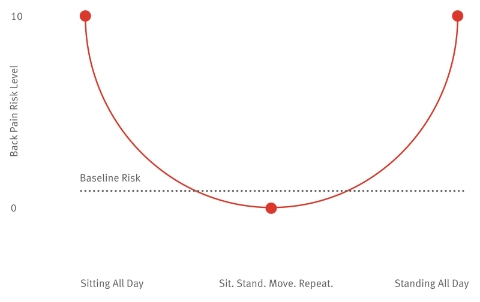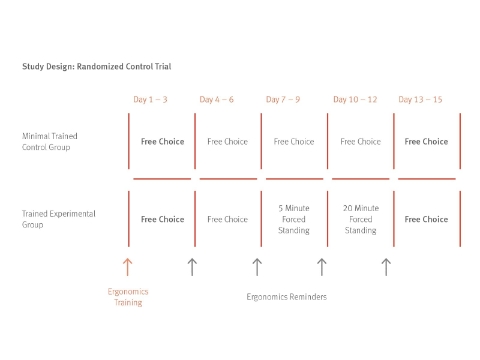Sit. Stand. Move. Repeat.
The Importance of Moving as a Natural Part of the Workday
Download PDF (493 KB)
Key Points
- In developed countries, people on average sit 3 to 8 hours a day.
- Prolonged sitting can cause injury, heart disease, and fatigue.
- Experts recommend standing 5 to 20 minutes each hour.
- Height-adjustable furniture can reduce sitting time by up to 60 percent.
- Training on how to adjust furniture multiplies its benefits.
The human body is made to move, and for the first six million years, humans either did (quickly and often), or they didn’t survive. Even during agrarian times, people spent their days moving from one chore to the next. Activity wasn’t built into life; it was life. Then came the Industrial Revolution and the era of industry and, soon after, high technology.
Today, in an era of ideas in which the greatest value is derived from creativity, many people sit much of the time. Nearly 50,000 adults around the world reported they sit three to eight hours each workday, with many of those in developed countries sitting more than nine hours a day.1 Sitting and seldom moving, office workers are therefore often drowsy, easily fatigued, and prone to injury. Providing people with natural ways to move throughout their workday can reverse these negative effects and contribute to people’s overall health.
What We Know
Our bodies are made for movement. Standing and moving are unique biological triggers that play a key role in being healthy. Unfortunately, the sedentary life that many office workers have adopted affects their health regardless of how much they eat or how much they exercise. A study that followed 17,000 Canadians, ages 18 to 90, for 12 years showed that “daily time spent sitting was associated with an elevated risk of all-cause and cardiovascular disease mortality…independent of leisure time physical activity levels and body mass index (BMI).”2
Sitting for extended time periods is linked with visual symptoms3, high triglycerides4, obesity5, insulin resistance6, cardiovascular disease7, and cancer8. Without regular and incidental standing and walking, the activity of lipo-protein lipase, the enzyme that breaks down plaque-causing fats in our blood, drops off significantly9.
Prolonged sitting has also been shown to result in increasing worker discomfort over the course of the workday.10 And, research shows an association between increasing discomfort and decreasing productivity, as well as future pain.11 What’s more, the causal chain from prolonged, immobile sitting to possible health risks exists even when one sits in a highly adjustable, ergonomically supportive work chair.
If sitting all day poses such risks, some say the answer is to stand. However, abandoning one’s chair to work all day at a stand-up surface is associated with its own hazards: lower extremity discomfort and fatigue, lower extremity swelling and venous pooling, lower back pain, and entire body fatigue.12

A physical workload that’s too low (sitting all day) or too high (standing all day) increases the risk of back pain. Ergonomists recommend standing about five minutes out of every hour, with some, such as James Mallon of Humantech, recommending up to 20 minutes.13
The risks associated with prolonged standing have prompted some to propose methods for increasing walking time over the course of the workday. Attempts have included combining a treadmill or a bicycle with a work surface. However, the health risks these methods present—in terms of eye strain and fatigue from a mismatch in support for gross and fine motor activities—outweigh any potential benefits.14
A third way is needed: because work requires sitting, standing, and moving, the ideal landscape of the workplace would naturally afford people choice among a variety of postures. The result is an environment that is good for both mind and body.
The practice of alternating between sitting and standing at work has been linked to increased HDL (good cholesterol)15, more frequent muscle contractions,16 decreased incidence of breathing difficulties17, and decreased swelling of the lower limbs.18 Sit-to-stand practices have also been linked with helping our bodies properly express the genes necessary to build healthy muscle.19 Sit-to-stand work reduces low back discomfort20 and causes significantly less discomfort compared to sitting-only work.21 Importantly, sit-to-stand working seems to show little or no decrease in productivity overall compared to seated office work.22 As discomfort decreases, in fact, productivity should increase.
Therefore
A combination of sitting, standing, and moving over the course of the workday—and not too much of any one activity—is the best approach to managing the balance between postural risk and physical comfort. Pairing a work landscape that includes postural choices with education to help people learn how to listen to their bodies equips them to make postural change a natural part of what they do at work.
Design Problem
The most appealing human environments are rooted in our natural modes of interaction and behavior. Because our bodies are made to move, we require environments that offer choices for a variety of postures throughout the day and across the office landscape. These choices must be such that people can immediately grasp where they can go and what they can do to achieve their goals and do their most meaningful work.
Design Solution
One part of the solution is providing furniture in appropriate settings so that people have options to sit, stand, and move during their workday. The other part consists of helping people understand the benefits of moving and changing their postures, as well as the basics of adjusting their furniture.
Furniture for Postural Variety
Herman Miller has always believed in the importance of supporting a variety of postures and encouraging healthy movement. In the 1960s, before the term ergonomics was widely known, designers such as George Nelson designed a stand-up, roll-top desk for the Action Office line, and Robert Propst designed a “perch,” which was a cross between a stool and a chair.
Because they themselves stood for part of their workday, these designers knew the benefits of standing, and their designs reflect that. These insights laid the groundwork for Bill Stumpf to design the Herman Miller's Ergon Chair, which introduced the science of ergonomics to the furniture industry and established a focus on health-positive seating at Herman Miller that has continued ever since.
Today, in addition to its line-up of performance work chairs, Herman Miller offers a selection of tables and desks that provide postural options through fast, easy height adjustability. Using electric adjustment systems—as opposed to weightbalanced, cantilevered approaches—these products offer ease of use that furthers the goal of helping people incorporate postural change into their everyday activities.
One of these products is the Renew sit-to-stand table, which is designed to make moving between sitting and standing postures intuitive. Designer Brian Alexander designed the feel of the table’s soft-edged, paddle-shaped switch so it can be used without looking at it or even thinking about it. A range of adjustments lets the user choose the perfect sitting or standing height, or share a space with others without compromising on comfort. Combined with a highly adjustable work chair that both encourages movement and supports the sitter properly, Renew gives the office worker a full range of healthy movement.
Locale is another solution that incorporates the importance of movement. Recognizing collaboration as a necessity of good business, designers Sam Hecht and Kim Colin conceived of Locale as neighborhoods that allow people to effortlessly transition from individual work to collaborative group and social activities. People move and change positions naturally because of Locale’s curved work surfaces that invite interaction and generously accommodate several people collaborating. Height-adjustable elements allow easy movement from seated, focused work to standing, collaborative interactions.
Educating People
Research has shown a strong correlation between training and actually using the standing posture in workspaces that are equipped with sit-to-stand capability.23 The most effective training focuses on helping people recognize musculoskeletal discomfort and risk, learn the value of varying their postures, and understand the reasons for behavioral change.24
Providing a variety of postural options combined with training and organizational support have also proven effective at reducing sitting time.25 On average, workers reduce their sitting time from 51 to 68 percent of their day to 20 to 30 percent when provided with a height-adjustable workstation.26 And, physical activity minutes are greater in organizations where psychosocial and environmental factors are both supportive of physical activity.27 Living in a supportive culture can result in 30 to 59 more minutes of physical activity per week for office workers who feel supported in the workplace.28
A study that considered the effects of ergonomic training and adjustable workspace design on musculoskeletal discomfort and performance is illustrative.29 During the first four days of the 15-day experiment, a control group of participants received standard instruction about the work setting and received the manufacturer’s pamphlet that gave instructions on chair adjustment. A second group of participants additionally heard a 1.5-hour instructional session that included case studies and hands-on practice periods.
The control group reported more than four times as many musculoskeletal symptoms as the trained group, which on some days had zero symptoms. In addition, performance accuracy was significantly higher for the trained group. They also reported a greater sense of control over the work environment because they were able to apply what they knew about the importance of sitting and standing throughout the day.
The results of the study underscore why training employees who spend much of their workday at the computer and following up with them is a smart investment for companies committed to a healthy workplace. The most basic tenet of ergonomics is that every solution should fit both the person and the task. Our tasks are changing, our work is changing, and our workplace must change with us. Part of that response should include changing the ways organizations provide for and individuals think about postural variety in the office.
Notes
1. Bauman, Adrian, et al., 2011. “The Descriptive Epidemiology of Sitting: A 20-Country Comparison Using the International Physical Activity Questionnaire,” American Journal of Preventive Medicine 41(2):228-235.
2. “Sitting Time and Mortality from All Causes, Cardiovascular Disease, and Cancer,” Peter T. Katzmarzyk, Timothy S. Church, Cora L. Craig, and Claude Bouchard, Medicine and Science in Sports and Exercise 41: 998-1005.
3. Amick, B.C., Menendez, C.C., Bazzani, L., Robertson, M., DeRango, K., Rooney, T., Harrist, R., Moore, A., 2012. A field intervention examining the impact of an office ergonomics training and a highly adjustable chair on visual symptoms in a public sector organization. Applied Ergonomics 43, 625-631.
4. Hamilton, M. T., Hamilton, D. G., & Zderic, T. W. 2007. ‘The Role of Low Energy Expenditure and Sitting on Obesity, Metabolic Syndrome, Type 2 Diabetes, and Cardiovascular Disease.’ Diabetes, 56(11), 2655-2667.
5. Thorp AA, Healy GN, Owen N, Salmon J, Ball K, Shaw JE, et al. Deleterious associations of sitting time and television viewing time with cardiometabolic risk biomarkers: Australian Diabetes, Obesity and Lifestyle (AusDiab) Study 2004–2005. Diabetes Care 2010;33(2):327–34.
6. Healy, G. N. et al. (2013). Reducing sitting time in office workers: Short-term efficacy of multicomponent intervention. Preventive Medicine, 57, 43-48.
7. Stephens BR, Granados K, Zderic TW, Hamilton MT, Braun B. Effects of 1 day of inactivity on insulin action in healthy men and women: interaction with energy intake. Metabolism 2011;60(7):941–9.
8. Hu FB, Li TY, Colditz GA, Willett WC, Manson JE. Television watching and other sedentary behaviors in relation to risk of obesity and type 2 diabetes mellitus in women. JAMA 2003;289(14):1785–91.
9. Proper, K.I., Koning, M., van der Beek, A.J., Hildebrandt, V.H., Bosscher, R.J., van Mechelen, W., 2003. The effectiveness of worksite physical activity programs on physical activity, physical fitness, and health. Clin. J. Sport Med. 13, 106–117.
10. Yates T, Khunti K, Wilmot EG, Brady E, Webb D, Srinivasan B, et al. Self-reported sitting time and markers of inflammation, insulin resistance, and adiposity. Am J Prev Med 2012;42(1):1–7.
11. Katzmarzyk, P.T., Church, T.S., Craig, C.L., Bouchard, C., 2009. Sitting time and mortality from all causes, cardiovascular disease, and cancer. Med. Sci. Sports Exerc. 41, 998–1005.
12. Weller, I., Corey, P., 1998. The impact of excluding non-leisure energy expenditure on the relation between physical activity and mortality in women. Epidemiology 9, 632–635.
13. Thorp, A.A., Owen, A., Neuhaus, M., Dunstan, D.W. 2011. American Journal of Preventive Medicine 41(2), 207-215.
14. Straker, L., Levine, J., and Campbell, A. The Effects of Walking and Cycling Computer Workstations on Keyboard and Mouse Performance. Human Factors: The Journal of the Human Factors and Ergonomics Society. December, 2009. 51(6), 831-844.
15. Gierach, G.L., Chang, S.C., Brinton, L.A., Lacey, J.V., Hollenbeck, A.R., Schatzkin, A., Leitzmann, M.F., 2009. Physical activity, sedentary behavior, and endometrial cancer risk in the NIH-AARP Diet and Health Study. Int. J. Cancer 124, 2139–2147.
16. Howard, R.A., Freedman, D.M., Park, Y., Hollenbeck, A.R., Schatzkin, A., Leitzmann, M.F., 2008. Physical activity, sedentary behavior, and the risk of colon and rectal cancer in the NIH-AARP Diet and Health Study. Cancer Causes Control 19, 939–953.
17. Hamilton, M. T., Hamilton, D. G., & Zderic, T. W. 2007. ‘The Role of Low Energy Expenditure and Sitting on Obesity, Metabolic Syndrome, Type 2 Diabetes, and Cardiovascular Disease.’ Diabetes, 56(11), 2655-2667.
18. Fenety, A., Walker, J.M., 2002. Short-term effects of workstation exercises on musculoskeletal discomfort and postural changes in seated video display unit workers. Physical Therapy 82(6),578-89.
19. McLean, L., Tingley, M., Scott, R.N., Rickards, J., 2001. Computer terminal work and the benefit of microbreaks. Applied Ergonomics 32(3), 225-237.
20. Callaghan, J.P., Gregory, D.E., Durkin, J.L., 2010. Do NIRS measures relate to subjective low back discomfort during sedentary tasks? International Journal of Industrial Ergonomics 40(2), 165-170.
21. Haynes, S., Williams, K., 2008. Impact of seating posture on user comfort and typing performance for people with chronic low back pain. Industrial Ergonomics 38,35-46.
22. Liao, M.H., Drury, C.G., 2000. Posture, discomfort and performance in a VDT task. Ergonomics 43(3),345-59.
23. Hamberg-van Reenen, H.H., van der Beek, A.J., Blatter, B.M., van der Grinten, M.P., van Mechelen, W., Bongers, P.M., 2008. Does musculoskeletal discomfort at work predict future musculoskeletal pain? Ergonomics 51(5), 637-648.
24. Chest, M.R., Malgorzata, J.R., Konz, S.A., 2002. Leg swelling, comfort and fatigue when sitting, standing, and sit/standing. International Journal of Industrial Ergonomics 29, 289-296.
25. Magora, A. (1972) Investigation of the relation between low back pain and occupation III. Physical requirements: sitting, standing and weight lifting, Industrial Medicine, 41, 5-9.
26. Alkhajah, T. A. (2012). Sit-Stand Workstations: A Pilot Intervention to Reduce Office Sitting Time. American Journal of Preventive Medicine, 43(3), 298-303.
28. Peeters, G., Burton, N.W., and Brown, W. J. (2013) Associations between sitting time and a range of symptoms in mid-age women. Preventive Medicine 56, 135-141.
29. Michelle M. Robertson, Ph.D., CPE, Vincent M. Ciriello, ScD., CPE, Angela M. Garabet, MS. Randomized Control Testing of Training and Workstation Design; Proceedings of the 17th Congress of the International Ergonomics Association: Changes, Challenges and Opportunities; August 9-14, 2009, Beijing, China.

